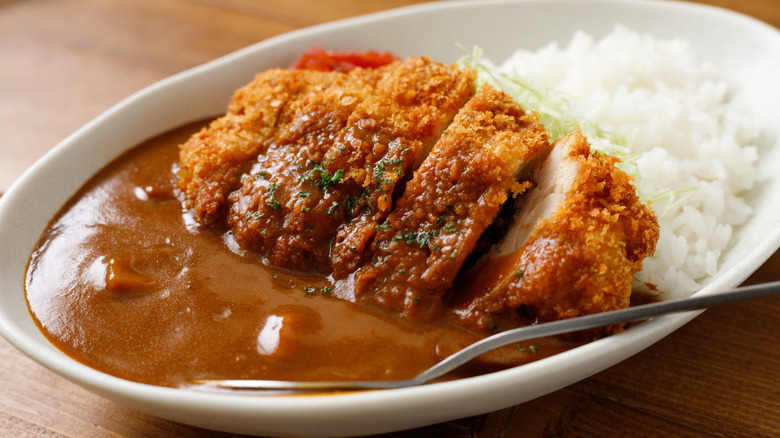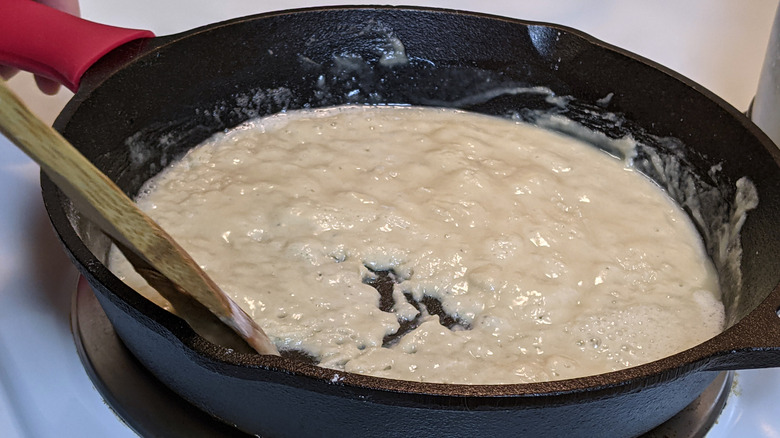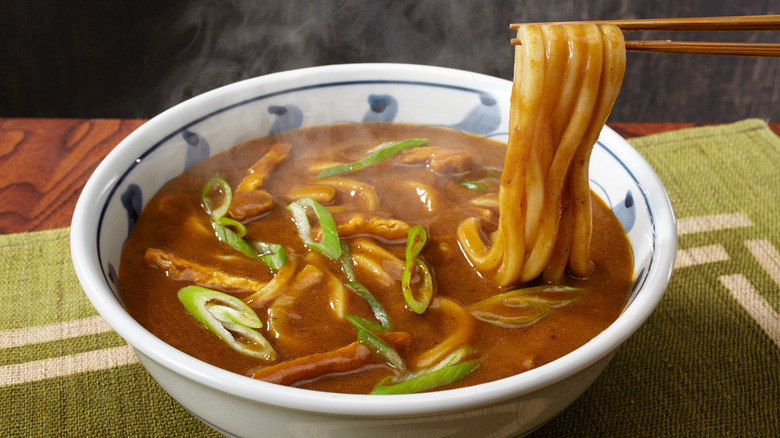What Makes Japanese Curry Unique
We may receive a commission on purchases made from links.
Japanese curry is a thing, and so are Thai curries, Jamaican curry, and British curry. England's national dish is chicken tikka masala, a creamy tomato-based curry. They all came from an Indian dish, right? Not exactly. Is your foodie mind blown? The Atlantic reports that, per Raghavan Iyer, a curry can refer to any Indian dish with a sauce or gravy. But the concept of curry originated among the colonial British, who developed curry powders to simplify the complex seasoning practices used throughout Indian cooking (per Atlas Obscura). The resulting dishes became wildly popular in Europe and later Japan, where they were further tweaked, per Metropolis.
So what about curry powder? Spice blends called masalas are common in Indian cuisine and typically contain a wider variety and higher concentration of spices than you'd see in curry powder. Spiceography explains that warming garam masalas are not turmeric-based and are typically added to a finished dish, while curry powder contains mostly turmeric and is used during cooking. Confusingly, there's also a curry tree used in cooking and a curry plant that's just ornamental, per Gardening Know How. In Japan, there's no mistaking a Japanese curry or karē, and here's what makes them stand out in a crowded culinary stage.
Japanese curries start with a roux
Japanese curries, writes Japanese Taste, are mild and sweet compared to similar Southeast Asian dishes that can be quite hot. Their unique flavor may come from apples, carrots, or honey; MasterClass' recipe uses molasses. Japanese curries call for Japanese pantry staples like soy sauce and mirin while Indian curries don't. In Thai cooking, for example, you can find different colors of curry paste, and in India there are countless spice blends — but Japanese curry is typically consistent in taste, texture, and appearance: soupy, thick, and brown.
There's a specific reason for this. Unlike many of their Indian counterparts that use coconut milk, the sauce for Japanese curries is made using a roux. MasterClass explains that a roux combines flour and fat as a sauce base, and when making Japanese curry you can make a roux from scratch or buy premade curry blocks, flakes, or pouches of curry sauce. You can also make your own curry powder or purchase some. MasterClass adds that you smother beef or chicken and vegetables in the rich brown sauce and serve it with rice, noodles, or bread, boiled egg, and Japanese pickles called fukujinzuke that frequently includes chopped-up fermented daikon radish and lotus root.
Cooking Japanese curry at home
There are many forms of Japanese curry, including katsu curry, which features pork or chicken cutlets over rice (per MasterClass). You can also use hearty beef or even seafood. The richly spiced sauce can be added to ramen broth (per Food Network), fried rice, or noodles, like in Just One Cookbook's aromatic curry udon. For vegetarian versions, use tofu or chunky veggies like cauliflower, broccoli, bok choy, and sweet potatoes. It's an easy, healthy dish.
And don't be ashamed of shortcuts; "Chef's Table" star Ivan Orkin shows home cooks how to fancy up boxed Japanese curry mix on YouTube. Chef's Wonderland suggests products like S&B Curry Powder and House Foods' "Vermont Curry" Roux — extremely popular in Japan and available at Asian grocery stores or online. "Curry" was invented by intermingled tastes and cultures. You're now equipped to start building your own spice blends and sauce and adding hearty, healthful, homemade curries to your meal plan.


